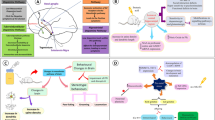Abstract
Ifenprodil, an antagonist of NMDA receptors containing the NR2B subunit, was expected to exhibit anticonvulsant action in rat pups up to the third postnatal week because of predominance of NR2B subunit at early development. Cortical epileptic afterdischarges (ADs) were used to study possible effects on threshold current intensities and duration of ADs in 12-, 15-, 18-, and 25-day-old rats. A series of 18 stimulation series with stepwise increasing current intensities (from 0.2 to 15 mA) was applied with 10-min intervals. The first experiment studied rats pretreated with ifenprodil (20 or 40 mg/kg), the second experiment studied an effect of ifenprodil on already present ADs—the dose of 20 mg/kg was administered after stimulation with the 3.5-mA current intensity. Pretreatment with ifenprodil resulted in an anticonvulsant effect in 15-day-old rats only, on the contrary, proconvulsant action was found in 18- and 25-day-old animals (decrease of thresholds especially for transition into the second, limbic type of ADs and increase in duration of ADs). Anticonvulsant effect was found in 12-, 15-, and 18-day-old rats in the second experiment—ADs were shortened. In contrast, no effect was observed in 25-day-old animals. An anticonvulsant action of ifenprodil is not only age-dependent but also activation-dependent.






Similar content being viewed by others
References
Babb TL, Mikuni N, Najm I, Wylie C, Olive M, Dollar C, MacLennan H (2005) Pre- and postnatal expressions of NMDA receptors 1 and 2B subunit proteins in the normal rat cortex. Epilepsy Res 64:23–30
Browning RA, Nelson DK (1986) Modification of electroshock and pentylenetetrazol seizure patterns in rats after precollicular transections. Exp Neurol 93:546–556
Castellano C, Cestari V, Ciamei A (2001) NMDA receptors and learning and memory processes. Curr Drug Targets 2:273–283
Chapman AG (1991) Excitatory amino acid antagonists and therapy of epilepsy. In: Meldrum BS (ed) Excitatory amino acid antagonists. London, Blackwell, pp 265–286
Fischer G, Mutel V, Trube G, Malherbe P, Kew JN, Mohacsi E, Heitz MP, Kemp JA (1997) Ro 25–6981, a highly potent and selective blocker of N-methyl-d-aspartate receptors containing the NR2B subunit. Characterization in vitro. J Pharmacol Exp Ther 283:1285–1292
Gallagher MJ, Huang H, Pritchett DB, Lynch DR (1996) Interactions between ifenprodil and the NR2B subunit of the N-methyl-d-aspartate receptor. J Biol Chem 271:9603–9611
Ghasemi M, Schachter SC (2011) The NMDA receptor complex as a therapeutic target in epilepsy: a review. Epilepsy Behav 22:617–640
Gogas KR (2006) Glutamate-based therapeutic approaches: NR2B receptor antagonists. Curr Opin Pharmacol 6:68–74
Kew JNC, Trube G, Kemp JA (1996) A novel mechanism of activity-dependent NMDA receptor antagonism describes the effect of ifenprodil in rat cultured cortical neurones. J Physiol 497:761–772
Kohl BK, Dannhardt G (2001) The NMDA receptor complex: a promising target for novel antiepileptic strategies. Curr Med Chem 8:1275–1289
Kubová H, Makal V, Miňová M, Vaňková S, Mareš P (1990) Influence of clonazepam on cortical epileptic afterdischarges in rats. Arch int Pharmacodyn 307:49–59
Lim AL, Taylor DA, Malone DT (2012) Consequences of early life MK-801 administration: long-term behavioural effects and relevance to schizophrenia research. Behav Brain Res 227:276–286
Lynch DR, Shim SS, Seifert KM, Kurapathi S, Mutel V, Gallagher MJ, Guttmann RP (2001) Pharmacological characterization of interactions of Ro 25–6981 with the NR2B (epsilon2) subunit. Eur J Pharmacol 416:185–195
Mareš P, Mikulecká A (2009) Different effects of two NMDA receptor antagonists on seizures, spontaneous behavior and motor performance in immature rats. Epilepsy Behav 14:32–39
Mareš P, Folbergrová J, Kubová H (2004) Excitatory aminoacids and epileptic seizures in immature brain. Physiol Res 53(Suppl1):S115–S124
McAllister KH (1992) N-methyl-D-aspartate receptor antagonists and channel blockers have different effects upon a spinal seizure model in mice. Eur J Pharmacol 211:105–108
Mikolášová R, Velíšek L, Vorlíček J, Mareš P (1994) Developmental changes of ketamine action against epileptic afterdischarges induced by hippocampal stimulation in rats. Dev Brain Res 81:105–112
Mikulecká A, Mareš P (2002) NMDA receptor antagonists impair motor performance in immature rats. Psychopharmacology 162:364–372
Paoletti P, Bellone C, Zhou C (2013) NMDA receptor subunit diversity: impact on receptor properties, synaptic plasticity and disease. Nat Rev Neurosci 14:383–400
Rezvani AH (2006) Involvement of the NMDA system in learning and memory. In: Levin ED, Buccafusco JJ (eds) Animal model of cognitive impairment. CRC Press, Boca Raton, Chapter 4
Riedel G, Platt B, Micheau J (2003) Glutamate receptor function in learning and memory. Behav Brain Res 140:1–47
Tabashidze N, Mareš P (2011) GABA-A receptors play a minor role in cortical epileptic afterdischarges in immature rats. Brain Res 1412:102–107
Tsuda M, Suzuki T, Misawa M (1997) Age-related decrease in the antiseizure effect of ifenprodil against pentylenetetrazole in mice. Dev Brain Res 104:201–204
Wang XM, Bausch SB (2004) Effects of distinct classes of N-methyl-d-aspartate antagonists on seizures, axonal sprouting and neuronal loss in vitro: suppression by NR2B antagonists. Neuropharmacology 47:1008–1020
Wenzel A, Fritschy JM, Mohler H, Benke D (1997) NMDA receptor heterogeneity during postnatal development of the rat brain: differential expression of the NR2A, NR2B, and NR2C subunit proteins. J Neurochem 68:469–478
Williams K (1993) Ifenprodil discriminates subtypes of the N-methyl-d-aspartate receptor: selectivity and mechanisms at recombinant heteromeric receptors. Mol Pharmacol 44:851–859
Wyllie DJA, Livesey MR, Hardingham GE (2013) Influence of GluN2 subunit identity on NMDA receptor function. Neuropharmacology 74:4–17
Yen W, Williamson J, Bertram EH, Kapur J (2004) A comparison of three NMDA receptor antagonists in the treatment of prolonged status epilepticus. Epilepsy Res 59:43–50
Yourick DL, Repasi RT, Rittase WB, Staten LD, Meyerhoff JL (1999) Ifenprodil and arcaine alter amygdala-kindling development. Eur J Pharmacol 371:147–152
Acknowledgements
This study was supported by a project of the Grant Agency of the Czech Republic no. P302/12/G069. The author would like to thank to Ms.Irina Nesev for excellent technical assistance.
Author information
Authors and Affiliations
Corresponding author
Rights and permissions
About this article
Cite this article
Mareš, P. Age and activation determines the anticonvulsant effect of ifenprodil in rats. Naunyn-Schmiedeberg's Arch Pharmacol 387, 753–761 (2014). https://doi.org/10.1007/s00210-014-0987-z
Received:
Accepted:
Published:
Issue Date:
DOI: https://doi.org/10.1007/s00210-014-0987-z




